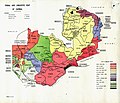The Zambia Portal
Zambia, officially the Republic of Zambia, is a landlocked country at the crossroads of Central, Southern and East Africa. It is typically referred to being in South-Central Africa or Southern Africa. It is bordered to the north by the Democratic Republic of the Congo, Tanzania to the north-east, Malawi to the east, Mozambique to the southeast, Zimbabwe and Botswana to the south, Namibia to the southwest, and Angola to the west. The capital city of Zambia is Lusaka, located in the south-central part of Zambia. The population is concentrated mainly around Lusaka in the south and the Copperbelt Province to the north, the core economic hubs of the country. Originally inhabited by Khoisan peoples, the region was affected by the Bantu expansion of the thirteenth century. Following European explorers in the 18th century, the British colonised the region into the British protectorates of Barotziland–North-Western Rhodesia and North-Eastern Rhodesia towards the end of the 19th century. These were merged in 1911 to form Northern Rhodesia. For most of the colonial period, Zambia was governed by an administration appointed from London with the advice of the British South Africa Company. On 24 October 1964, Zambia became independent of the United Kingdom and prime minister Kenneth Kaunda became the inaugural president. Kaunda's socialist United National Independence Party (UNIP) maintained power from 1964 until 1991. Kaunda played a key role in regional diplomacy, cooperating closely with the United States in search of solutions to conflicts in Southern Rhodesia (Zimbabwe), Angola, and Namibia. From 1972 to 1991 Zambia was a one-party state with UNIP as the sole legal political party under the motto "One Zambia, One Nation" coined by Kaunda. Kaunda was succeeded by Frederick Chiluba of the social-democratic Movement for Multi-Party Democracy in 1991, beginning a period of socio-economic development and government decentralisation. Zambia has since become a multi-party state and has experienced several peaceful transitions of power. Zambia contains abundant natural resources, including minerals, wildlife, forestry, freshwater, and arable land. In 2010, the World Bank named Zambia among the top 10 reformers in the World Bank's Ease of doing business index. The Common Market for Eastern and Southern Africa (COMESA) is headquartered in Lusaka. ( Full article...) Selected article -Kitwe is the third largest city in terms of infrastructure development (after Lusaka and Ndola) and second largest city in terms of size and population (after Lusaka) in Zambia. With a population of 517,543 (2010 census provisional) Kitwe is one of the most developed commercial and industrial areas in the nation, alongside Ndola and Lusaka. It has a complex of mines on its north-western and western edges. Kitwe is located in the Copperbelt Province and is made up of townships and suburban areas including Parklands, Riverside, Buchi, Chimwemwe, Kwacha, Nkana East, Nkana West, Garneton, Ndeke, Miseshi, Wusakile, Mindolo, Chachacha and Race Course, to mention a few. The city is sometimes referred to as Kitwe-Nkana. Nkana is derived from the name of Senior Chief Nkana of the Lamba speaking people of the Copperbelt province. His area covers the towns of Kitwe, Mufulira, Kalulushi-Chibuluma and Chambishi. ( Full article...)General images -The following are images from various Zambia-related articles on Wikipedia.
This is a
Good article, an article that meets a core set of high editorial standards.
The 2010 Zambian census was conducted in Zambia in 2010 under the approval of the Government of Zambia, which recorded demographic data from 13 million people and 3.2 million households. The 2010 Census of Population and Housing was conducted between 16 October and 15 November 2010, with all parts of the country covered by 30 November 2010. It was the fifth national population census exercise of Zambia since its independence in 1964, with the previous censuses conducted in 1969, 1980, 1990 and 2000. A total of 3.2 million questionnaires were used for data collection and the processing started in April 2011 by the Central Statistical Office. Optical Mark Reading (OMR) and Intelligent Character Recognition (ICR) technology were used for data capture. The census was funded by United Nations Population Fund (UNFPA), the United Kingdom AID (UKAID-formerly DFID), the United States Agency for International Development (USAID) and the African Development Bank ( AfDB), who contributed close to 60 per cent of the total expenditure and rest contributed by the Ministry of Finance of the Government of Zambia. As per the census, Zambia had a total population of 13,092,666 including 6,454,647 males (49.2%) and 6,638,019 females (50.8%) with a sex-ratio of 102.84. The total literacy of the population above the age of five stood at 70.2 per cent. Urban population constituted 39.51 per cent and the remaining 61.49 per cent resided in rural areas. The density of population was 17.4 persons per km2 and the decadal growth of population was 2.8 per cent. There were 22 major languages spoken in Zambia of which 33.5 per cent of the population spoke Bemba, making it the largest spoken language. Out of the seven broad ethnic groups, Bemba was the most prevalent tribal group (21.0%), followed by Tonga (13.6%). The national average of active people stood at 55.5 per cent with 50.2 in rural areas and 65.3 per cent in urban areas. Unemployment rate was 13 per cent as of 2010. Agriculture was the major occupation with 66.5 per cent involved in it. The proportion of people living under poverty line was 60.5 per cent, while the extremely poor formed 42.3 per cent of the total population. ( Full article...)CategoriesRelated portalsTopicsWikiProjectsGeneral: Wikipedias in Zambian languages: Things to do
Associated WikimediaThe following Wikimedia Foundation sister projects provide more on this subject:
Discover Wikipedia using
portals | ||||
The Zambia Portal
Zambia, officially the Republic of Zambia, is a landlocked country at the crossroads of Central, Southern and East Africa. It is typically referred to being in South-Central Africa or Southern Africa. It is bordered to the north by the Democratic Republic of the Congo, Tanzania to the north-east, Malawi to the east, Mozambique to the southeast, Zimbabwe and Botswana to the south, Namibia to the southwest, and Angola to the west. The capital city of Zambia is Lusaka, located in the south-central part of Zambia. The population is concentrated mainly around Lusaka in the south and the Copperbelt Province to the north, the core economic hubs of the country. Originally inhabited by Khoisan peoples, the region was affected by the Bantu expansion of the thirteenth century. Following European explorers in the 18th century, the British colonised the region into the British protectorates of Barotziland–North-Western Rhodesia and North-Eastern Rhodesia towards the end of the 19th century. These were merged in 1911 to form Northern Rhodesia. For most of the colonial period, Zambia was governed by an administration appointed from London with the advice of the British South Africa Company. On 24 October 1964, Zambia became independent of the United Kingdom and prime minister Kenneth Kaunda became the inaugural president. Kaunda's socialist United National Independence Party (UNIP) maintained power from 1964 until 1991. Kaunda played a key role in regional diplomacy, cooperating closely with the United States in search of solutions to conflicts in Southern Rhodesia (Zimbabwe), Angola, and Namibia. From 1972 to 1991 Zambia was a one-party state with UNIP as the sole legal political party under the motto "One Zambia, One Nation" coined by Kaunda. Kaunda was succeeded by Frederick Chiluba of the social-democratic Movement for Multi-Party Democracy in 1991, beginning a period of socio-economic development and government decentralisation. Zambia has since become a multi-party state and has experienced several peaceful transitions of power. Zambia contains abundant natural resources, including minerals, wildlife, forestry, freshwater, and arable land. In 2010, the World Bank named Zambia among the top 10 reformers in the World Bank's Ease of doing business index. The Common Market for Eastern and Southern Africa (COMESA) is headquartered in Lusaka. ( Full article...) Selected article -Kitwe is the third largest city in terms of infrastructure development (after Lusaka and Ndola) and second largest city in terms of size and population (after Lusaka) in Zambia. With a population of 517,543 (2010 census provisional) Kitwe is one of the most developed commercial and industrial areas in the nation, alongside Ndola and Lusaka. It has a complex of mines on its north-western and western edges. Kitwe is located in the Copperbelt Province and is made up of townships and suburban areas including Parklands, Riverside, Buchi, Chimwemwe, Kwacha, Nkana East, Nkana West, Garneton, Ndeke, Miseshi, Wusakile, Mindolo, Chachacha and Race Course, to mention a few. The city is sometimes referred to as Kitwe-Nkana. Nkana is derived from the name of Senior Chief Nkana of the Lamba speaking people of the Copperbelt province. His area covers the towns of Kitwe, Mufulira, Kalulushi-Chibuluma and Chambishi. ( Full article...)General images -The following are images from various Zambia-related articles on Wikipedia.
This is a
Good article, an article that meets a core set of high editorial standards.
The 2010 Zambian census was conducted in Zambia in 2010 under the approval of the Government of Zambia, which recorded demographic data from 13 million people and 3.2 million households. The 2010 Census of Population and Housing was conducted between 16 October and 15 November 2010, with all parts of the country covered by 30 November 2010. It was the fifth national population census exercise of Zambia since its independence in 1964, with the previous censuses conducted in 1969, 1980, 1990 and 2000. A total of 3.2 million questionnaires were used for data collection and the processing started in April 2011 by the Central Statistical Office. Optical Mark Reading (OMR) and Intelligent Character Recognition (ICR) technology were used for data capture. The census was funded by United Nations Population Fund (UNFPA), the United Kingdom AID (UKAID-formerly DFID), the United States Agency for International Development (USAID) and the African Development Bank ( AfDB), who contributed close to 60 per cent of the total expenditure and rest contributed by the Ministry of Finance of the Government of Zambia. As per the census, Zambia had a total population of 13,092,666 including 6,454,647 males (49.2%) and 6,638,019 females (50.8%) with a sex-ratio of 102.84. The total literacy of the population above the age of five stood at 70.2 per cent. Urban population constituted 39.51 per cent and the remaining 61.49 per cent resided in rural areas. The density of population was 17.4 persons per km2 and the decadal growth of population was 2.8 per cent. There were 22 major languages spoken in Zambia of which 33.5 per cent of the population spoke Bemba, making it the largest spoken language. Out of the seven broad ethnic groups, Bemba was the most prevalent tribal group (21.0%), followed by Tonga (13.6%). The national average of active people stood at 55.5 per cent with 50.2 in rural areas and 65.3 per cent in urban areas. Unemployment rate was 13 per cent as of 2010. Agriculture was the major occupation with 66.5 per cent involved in it. The proportion of people living under poverty line was 60.5 per cent, while the extremely poor formed 42.3 per cent of the total population. ( Full article...)CategoriesRelated portalsTopicsWikiProjectsGeneral: Wikipedias in Zambian languages: Things to do
Associated WikimediaThe following Wikimedia Foundation sister projects provide more on this subject:
Discover Wikipedia using
portals | ||||


























































